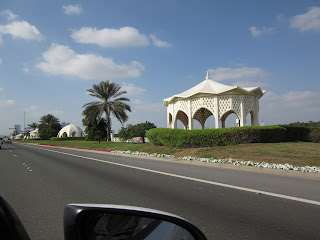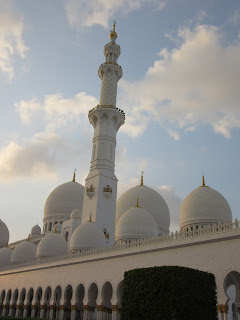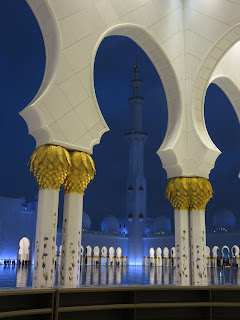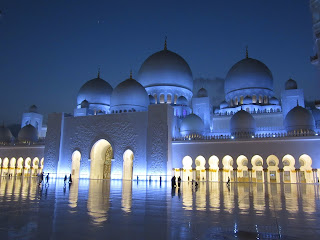After flying from Cape Town to Dubai in the United Arab Emirates and then immediately driving south to the city of Abu Dhabi to visit the mammoth Abu Dhabi Falcon Hospital, we were on our way in the early afternoon to the Women's Handicraft Center as it closed shortly for the weekend.
En route, it was sort of hard to miss the giant UAE flag and portraits of UAE leaders! I couldn't find out who the man was on the right but the one on the left was President Khalifa bin Zayed Al Nahyan, known simply as Sheikh Khalifa. He became the head of state in November 2004, following the death of his father, Zayed bin Sultan Al Nahyan who was known as Sheikh Zayed. Officially, the president is elected every five years by the Federal Supreme Council, but because the ruler of Abu Dhabi customarily also holds the presidency of the UAE, the office is de facto hereditary.
En route, it was sort of hard to miss the giant UAE flag and portraits of UAE leaders! I couldn't find out who the man was on the right but the one on the left was President Khalifa bin Zayed Al Nahyan, known simply as Sheikh Khalifa. He became the head of state in November 2004, following the death of his father, Zayed bin Sultan Al Nahyan who was known as Sheikh Zayed. Officially, the president is elected every five years by the Federal Supreme Council, but because the ruler of Abu Dhabi customarily also holds the presidency of the UAE, the office is de facto hereditary.
A sneak peak of the Sheikh Zayed Grand Mosque that was on our list to tour after the Handicraft Center.
This mammoth image of UAE soldiers graced the exterior of another building.
The Women's Handicraft Center was a creative initiative run by the Abu Dhabi Women's Association and funded by the government to showcase and help preserve local arts and crafts, including jewelry and dressmaking. All the workshops were unfortunately closed but at least the museum was open.

It was our only opportunity to examine and learn about local artists' handiwork. After welcoming us with tea, the guide told us that all items made in the workshops were done by local single women who were either divorced or widowed.
In the Telli exhibit, we learned that telli is one of the well known handicrafts in the UAE. Telli, used in decorating dresses, is a strap of colored, lapping silk threads.
UAE women in the Khous Workshop at the Center use palm tree branches to make many products including mats. The branches are cut and exposed to sun until the color changes from green to white. In making khous, the women don't just rely on the palms' natural color but combine that with other colors.
After appreciating the example of weaving brocade called sidduh, we left the Center.
More views of the Grand Mosque:
I liked how the sound barriers were decorated with the desert motif.
We drove along the splendid waterfront corniche en route to checking into our hotel located in the downtown area.
The road was lined with an impressive string of high, glass-fronted towers. These were two of the planned three buildings that comprised the Abu Dhabi World Trade Center.
Near the hotel was the interesting Al Ittihad Square which was dotted with a striking sequence of four quirky over sized sculptures, including an enormous perfume bottle and a gargantuan coffee pot!
Steven and I felt like we were in scenes from Alice in Wonderland looking at these immense sculptures!
There were supposed to have been five sculptures but one was missing!
FYI: In 2013, the UAE's population was 9.2 million, of which 1.4 million were Emirati citizens and 7.8 million were expatriates. The Emirates is divided into seven emirates or hereditary absolute monarchies. Dubai is the most populated Emirate with 35% of the UAE population. The Emirate of Abu Dhabi has an another 31%, meaning that over two-thirds of the UAE population live in either Abu Dhabi or Dubai.
We walked next to the Al Hosn Fort in the very heart of the city. The large white fort was built in about 1763 to protect the town's water source. The outer walls and towers were added later. At one time, it was the only noteworthy building along the coast between Dubai and Doha in Qatar. Until 1972, when Sheikh Zayed moved into a new palace, it was also the ruler's residence. The entire complex had been closed for years for redevelopment and no one knew when it was slated to reopen.
After walking for a good while downtown, Steven and I both thought that downtown Abu Dhabi was pretty dumpy with generally unimaginative architecture and cracked sidewalks everywhere. It felt like it was the proverbial 'ugly stepsister' to Dubai up the road even though it was the capital city of the United Arab Emirates
These high rises were more interesting, granted.
Although it was far from obvious, Abu Dhabi, which means Father of the Gazelle, was actually built on an island.
Rising over the southern part of the city was undoubtedly Abu Dhabi's single most worthwhile attraction, the Sheikh Zayed Grand Mosque. There are almost 19,000 reviews of the mosque on Trip Advisor to give you an idea of why we wanted to visit it!
The spectacular, snow-white mass of domes and minarets had been visible for miles around. Completed in 2007, the mosque was one of the world's biggest and certainly the the most expensive, having cost some $500 million! It was only one of three mosques in the Emirates open to non-Muslims.
The dress code to enter the mosque was very explicit for both men and women. A woman's arms and legs had to be fully covered in order to enter the mosque. In 2013, singer Rihanna received negative criticism for taking photographs, with the mosque in the background, during a private visit. During the incident, when she was reported to have posed in a manner deemed offensive and provocative, staff asked her to leave following the incident! More recently, Selena Gomez was criticized by Instagram users for posing for pictures at the mosque with her ankle shown.
The project to build the mosque was begun by the late president of the United Arab Emirates, Sheikh Zayed bin Sultan Al Nahyan, who wanted to establish a structure that would unite the "cultural diversity of the Islamic world with the historical and modern values of architecture and art." His final resting place was located on the grounds beside the mosque.
The enormous building complex measures approximately 960 ft by 1,380 ft, covering an area of more than 30 acres, not including exterior landscaping and parking!
The Sheikh Zayed Grand Mosque's design and construction "unites the world", using artisans and materials from many countries
including India, Italy, Germany, Morocco, Pakistan, Turkey, Malaysia, Iran, China, United Kingdom, New Zealand, Republic of Macedonia and the UAE.
More than 3,000 workers and 38 contracting companies took part in the construction of the mosque.
We hadn't known when we arrived at the mosque that the last tour of the day was about to start at 5 so we had spent time wandering around the most impressive complex before entering it. It was only after a good amount of pleading on my part and saying (truthfully, of course) this was our only chance to take a tour that we were finally able to join in as it had already started by then. I can't tell you how thankful we were!
There were four minarets on the four corners of the courtyard which rose about 351 ft in height.
Natural materials were chosen for much of its design and construction due to their long-lasting qualities, including marble, gold, semi-precious stones, crystals and ceramics.
As the country's grand mosque, Sheikh Mosque is the key place of worship for gathering on Friday mornings - the beginning of the Muslim weekend - and holiday prayers.
The massive courtyard, with its stunning floral design, measured about 180,000 sq ft, and is considered to be the largest example of marble mosaic in the world. It could accommodate 17,400 worshipers but, when the additional halls are full during the Muslim religious holidays of Ramadan and Eid, 31,000 faithful can pray at the mosque! The main prayer hall could accommodate over 7,000 worshipers. Two smaller prayer halls, with a capacity of 1,500 each, one of which is the female prayer hall, were also part of the mosque.
The guide explained that there were more than one thousand million pieces of mosaic in the courtyard floor which was designed by a Briton.
Gold adorned the top of each of the 82 onion-shaped domes, according to the guide. This dome, which contained the first library ever included in a mosque, served the Muslim community with classic books and publications addressing a range of Islamic subjects: sciences, civilization, calligraphy, the arts, coins and included some rare publications dating back more than 200 years. In reflection of the diversity of the Islamic world and the United Arab Emirates, the collection included material in a broad range of languages, including Arabic, English, French, Italian, Spanish, German and Korean.
Another of the four minarets:
Three calligraphy styles were used throughout the mosque. The style in the ceilings of the long corridor was called Kufic.

In the main prayer hall alone, there were a staggering 1,096 pillars and either 94 or 96 columns depending on what source you believed.
Our guide mentioned that the six-sided columns represented date palms and were clad with Italian marble and inlaid with mother of pearl and semi-precious stones, including lapis lazuli. To say that they were magnificent was an understatement!
Surrounding the mosque were 22 towers with different types of lighting and each with 10-15 projectors to reflect the clouds and phases of the moon onto the pools, according to our guide.
I would hazard a guess that this had to be the fanciest water fountain we've ever encountered!
Prior to entering the main prayer hall, everyone had to remove their shoes.
Our guide led us through the middle of the three entrances; the others, she explained were on the north and south sides of the hall. She told us that males and females don't pray together because Muslims believe women want privacy when they pray.
The guide revealed that there were seven domes in the mosque but this one was just the 'baby one' weighing only 1.5 to 2 tons! The chandeliers, incorporating millions of Swarovski crystals, came from the Faustig Company in Munich.

The flowers decorating the walls and floor represented the image of the garden Muslims have in heaven, according to their faith. The mosque’s main floral displays are not the work of a garden designer or a landscape architect but of Kevin Dean, an English artist and designer trained at the Royal College of Art. He had worked for clients such as the Natural History Museum in London and the Smithsonian in Washington.
Dean was already an established designer of floral designs and motifs, producing designs for clients such as the British stores Marks & Spencer and Laura Ashley. He had also provided the botanic illustrations for several best-selling children’s books. In an interview, Dean explained that he had come from a family of gardeners and he'd always been interested in flowers and drawn them since he was quite young.
Despite this experience, however, Dean stated that the scale of the project took a little getting used to. The mosque’s main courtyard alone provided an almost 200,000-square foot canvas. "It’s a bit daunting when you think about the scale, but if you forget about all that and just treat it as a design within a space then everything follows," he recollected.
Dean used flowers found in the Middle Eastern region, mostly irises, tulips, lilies and roses.
This was one of twelve clocks in the prayer halls and each was decorated with mother-of pearl. They listed the daily times for prayer as observed by the most faithful Muslims and also reminded Muslims when both Ramadan and Eid began and ended. The guide said Muslims can only pray in a clean place and must have washed some part of their bodies before praying.
The largest chandelier is the second largest known chandelier inside a mosque, the third largest in the world and had a 33 ft diameter and a 49 ft height. The 12 ton chandelier was held up by a wire that could support 13.5 tons! Cleaned twice a year, it uses 155,000 LED lights, our guide said.
The light at the bottom of the chandelier represented the fruit of the date palm and the chandelier mirrored the carpet design just below it.
The carpet in the main prayer hall was declared by the Guinness Book of World Records in 2007 to be the world's largest carpet. Designed by Iranian artist Ali Khaliqi, the carpet measured 60,570 sq ft, and was made by approximately 1,200-1,300 carpet knotters.
The 35-ton carpet was predominantly made from wool originating from New Zealand and Iran. There are 2,268,000,000 knots within the carpet and it took approximately two years to complete. It was brought into the mosque in nine pieces where it was then sewn together.
I forgot to write down what this part of the prayer hall was called next to the pulpit but our guide reported the gold represented the 'rivers of honey' and the white represented 'rivers of milk.
All Muslims have to learn the 99 qualities or attributes of Allah or God, she said, that were inscribed in the flowers that almost reached the ceiling. The qualities were featured on the Qibla wall in traditional Kufic calligraphy. The Qibla wall also featured subtle fiber-optic lighting as part of the organic design.
Sermons given by the imam, the leader of the mosque, normally last 10 to 15 minutes. The topics, not necessarily religious themes, are chosen by the country's Islamic leaders, not by the government, our guide pointed out.
Walking barefoot on the cool white marble or on the immense silk carpet was an experience we won't soon forget.
I could only marvel what an experience it would be to see 7,000 plus worshipers in the main prayer hall. With so few people though, there was a sense of absolute tranquility and serenity throughout the mosque.
Another of the amazing chandeliers:
The beautiful wood doors were made of teak from India.
The attention to detail throughout the mosque was unbelievable.
The mosque's floral motif was extended to each of the entryways.
I can't imagine ever seeing more cottony clouds in my life than these were; they were simply spectacular and added to the entire experience.
Retrieving our shoes from the shoe rack after the tour ended at 5:45.
I loved how one of the minarets was framed between the columns.
Steven and I have been lucky enough to visit some other stunning mosques in our trips around the world the last few years. The Sheikh Zayed Grand Mosque had to have been the most amazing modern mosque we have ever been to. With all the beautiful stark-white marble, it reminded me of a modern version of the Taj Mahal.
By the end of the tour, it was dark and the building was completely different with lights. That just meant even more photos of the mosque in the vastly different light!
The mosque's unique lighting system was designed by lighting architects to reflect the phases of the moon. Beautiful bluish gray clouds were projected in lights onto the external walls and get brighter and darker according to the phase of the moon.
The pools along the arcades reflected the mosque's spectacular columns, which were even more glorious at night, if that was possible.
The lighting made the architecture even more breathtaking at night.
We couldn't stop thinking how incredibly lucky we were having just made it on time to visit the only two places we wanted to do today, the Falcon Hospital and the Mosque. Visiting the Grand Mosque was an unforgettable experience. If ever there was a 'must-see' place to visit, this was it!
Posted on February 24th, 2017 from Littleton, Colorado.












































































































I agree that it is most beautiful. I'll have to add it to my bucket list. Lil Red
ReplyDelete